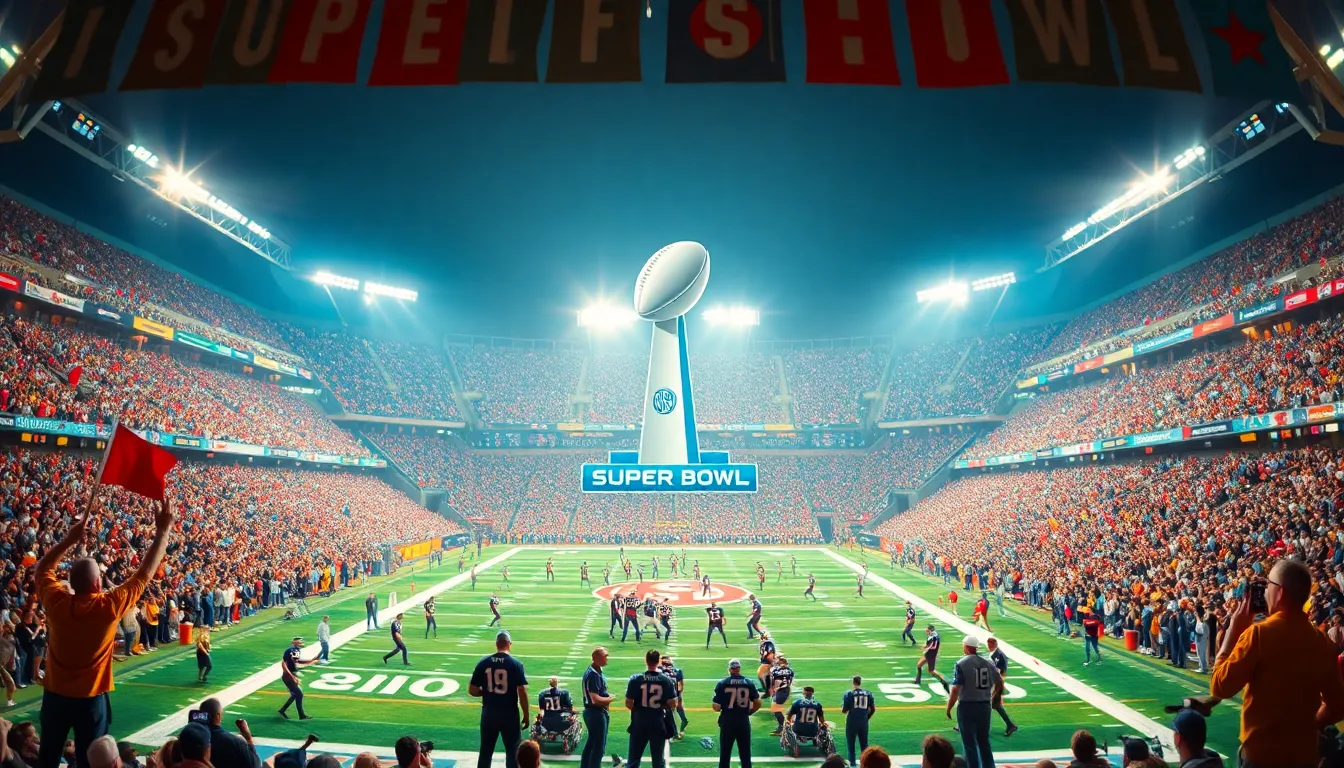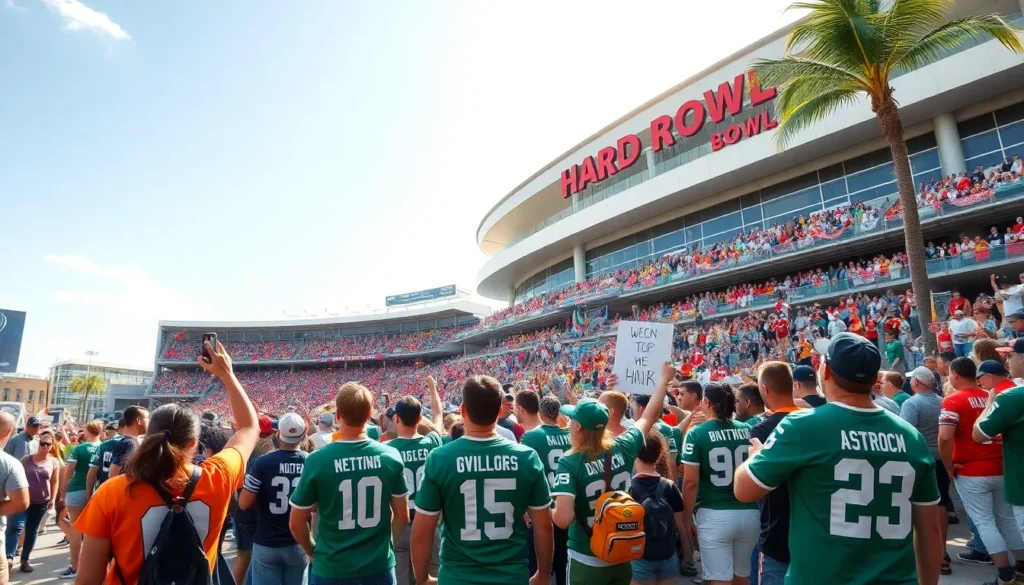Every year, football fans around the nation gear up for the biggest showdown in sports: the Super Bowl. But have you ever stopped to think about the epic venues that have hosted this monumental event? From sunny beaches to snowy mountains, the locations of the Super Bowl have added their own flair to the championship experience.
Table of Contents
ToggleOverview of Super Bowl Locations
Super Bowl locations span a wide array of cities and venues across the United States. Each site contributes a unique atmosphere, shaping fan experiences over the years. Notably, iconic stadiums like AT&T Stadium in Arlington, Texas, and Hard Rock Stadium in Miami, Florida, have hosted the event multiple times, showcasing their significance in NFL history.
The Super Bowl rotates through various regions, allowing different fan bases to engage with the championship. This rotation includes cities from the West Coast, such as San Francisco and Los Angeles, to East Coast locations like New York and New England. Diverse climates and settings enhance the overall excitement, with warm beach venues contrasting with colder, snow-laden sites.
In recent years, futuristic stadiums such as SoFi Stadium in Inglewood, California, have garnered attention, representing the latest in sports architecture. Other historic venues like the Rose Bowl in Pasadena, California, highlight the event’s long-standing tradition and celebratory spirit.
A comprehensive list of Super Bowl locations by year illustrates this evolution. Venues hosting the Super Bowl numerous times demonstrate their capacity to manage large events effectively. For instance, the Mercedes-Benz Stadium in Atlanta, Georgia, and the NRG Stadium in Houston have become regular fixtures on this prestigious stage.
Identifying trends in these locations can reveal the NFL’s marketing strategies and efforts to reach diverse demographics. While some cities flourish with repeat hosting opportunities, emerging stadiums in different regions indicate the league’s commitment to growth and fan engagement. These factors combined create a rich tapestry of memorable moments and locations in Super Bowl history.
Super Bowl Locations by Year

Super Bowl venues showcase a rich history, revealing how cities across the United States became iconic backdrops for this championship. This section outlines the significant locations by decade, noting key trends and memorable moments.
Early Years (1967-1979)
The inaugural Super Bowl took place in 1967 at the Los Angeles Memorial Coliseum. This stadium hosted the first ever match between the Green Bay Packers and the Kansas City Chiefs. Subsequent years saw venues like Tulane Stadium in New Orleans and the Orange Bowl in Miami showcasing the growing excitement. Notable for their intimate atmospheres, these sites laid the groundwork for future festivities.
The 1980s
The Rose Bowl in Pasadena emerged as a beloved location, hosting Super Bowls in 1982 and 1983. Venturing to more diverse destinations, the NFL embraced stadiums like Tampa Stadium and the Louisiana Superdome. Each venue reflected a unique regional flair, drawing fan bases into the celebration. By the end of the decade, stadiums were becoming more sophisticated, enhancing the viewing experience.
The 1990s
Super Bowl XXV at Tampa’s Raymond James Stadium marked a shift towards a stadium-centric approach. The NFL utilized sites such as the Georgia Dome and Qualcomm Stadium in San Diego to reach a wider audience. Fan engagement consistently increased during this decade, as cities like Atlanta and Miami offered lively environments. These venues became synonymous with unforgettable moments, contributing to the event’s growing mythology.
The 2000s
In this decade, venues like Reliant Stadium in Houston and Ford Field in Detroit emerged as crucial hosts. The expansion of stadium technology improved overall spectator experience. Each stadium reflected modern architectural advancements, with a focus on comfort and accessibility. As the NFL embraced new cities, fans enjoyed the excitement of a wide range of hosting environments.
The 2010s
This era included memorable Super Bowls at MetLife Stadium in East Rutherford and University of Phoenix Stadium in Glendale. Expecting drastic weather challenges, venues adapted to provide the best experience possible. Central locations drew in diverse crowds, promoting fan interaction. Host cities celebrated their cultural legacies, ensuring rich traditions punctuated the festivities.
Recent Years (2020-Present)
In the most recent years, SoFi Stadium in Inglewood and Raymond James Stadium in Tampa drew significant attention. These modern facilities offered state-of-the-art amenities while maintaining a vibrant atmosphere. The NFL’s choice of locations emphasized accessibility and inclusivity, inviting fans from all backgrounds. Iconic sites continue to evolve, shaping the future of Super Bowl celebrations and reinforcing community connections.
Impact of Location on Super Bowl Experience
Location influences every aspect of the Super Bowl experience, from the climate to local culture. Venues like Hard Rock Stadium in Miami offer a warm, festive atmosphere, while cold-weather locations such as MetLife Stadium in New Jersey provide a different, exhilarating challenge for fans. Event planning often takes advantage of distinct regional characteristics, allowing cities to showcase their identity.
Iconic stadiums such as the Rose Bowl and AT&T Stadium enhance the viewing experience through innovative designs and amenities. Each venue’s architecture plays a significant role in shaping fan interactions, engagement, and enjoyment. Cities across the United States maximize local attractions and hospitality to create memorable experiences. Football fans can immerse themselves in vibrant pre-game festivities that reflect the best of the host city.
Frequency of hosting also affects community involvement and economic benefits. Regular Super Bowl locations attract sponsorships and business investments, further enhancing the fan experience. The stadiums evolve to meet modern demands, incorporating technology that enhances engagement.
Climate considerations add another layer of complexity, particularly when outdoor venues face adverse weather. Weather can impact game-day attire and overall comfort for attendees. Local cuisine and entertainment contribute to the overall atmosphere, creating a unique environment for each Super Bowl celebration.
As hosting cities continue to evolve, they adapt to trends in fan experiences and preferences. Recent locations display a commitment to inclusivity and accessibility, ensuring all attendees can participate fully. Super Bowl venues encapsulate not just football, but also a celebration of community and culture, making each event a unique and unforgettable experience.
The journey through Super Bowl locations reveals much more than just a list of stadiums. Each venue tells a story of community spirit and cultural celebration that enriches the event. From the sunny shores of Miami to the snowy landscapes of New Jersey, the diversity of locations enhances the Super Bowl experience for fans nationwide.
As the NFL continues to innovate and adapt, future venues will likely blend modern architecture with local charm, ensuring every Super Bowl remains a memorable occasion. The evolution of these locations reflects the league’s commitment to inclusivity and accessibility, fostering a sense of belonging for all fans. With each passing year, the Super Bowl not only crowns a champion but also showcases the vibrant tapestry of American culture and community.





